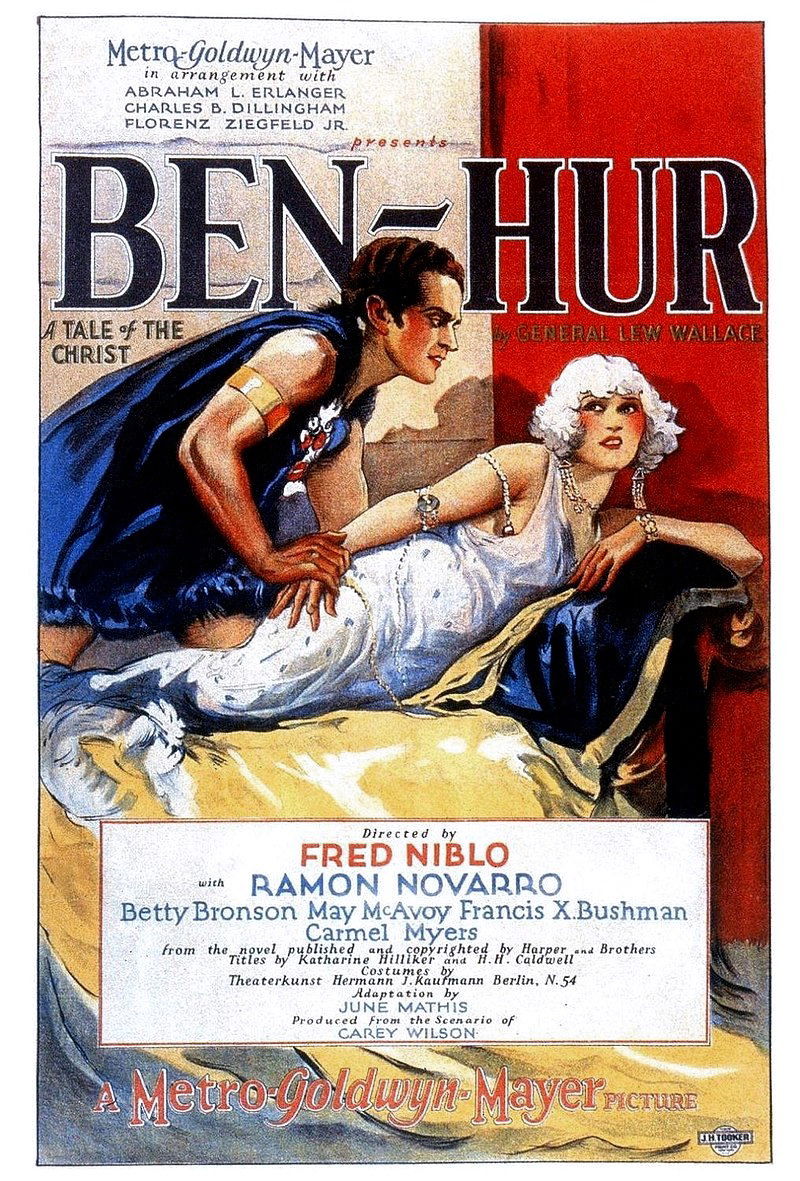THE FIRST COLOSSAL FILMS
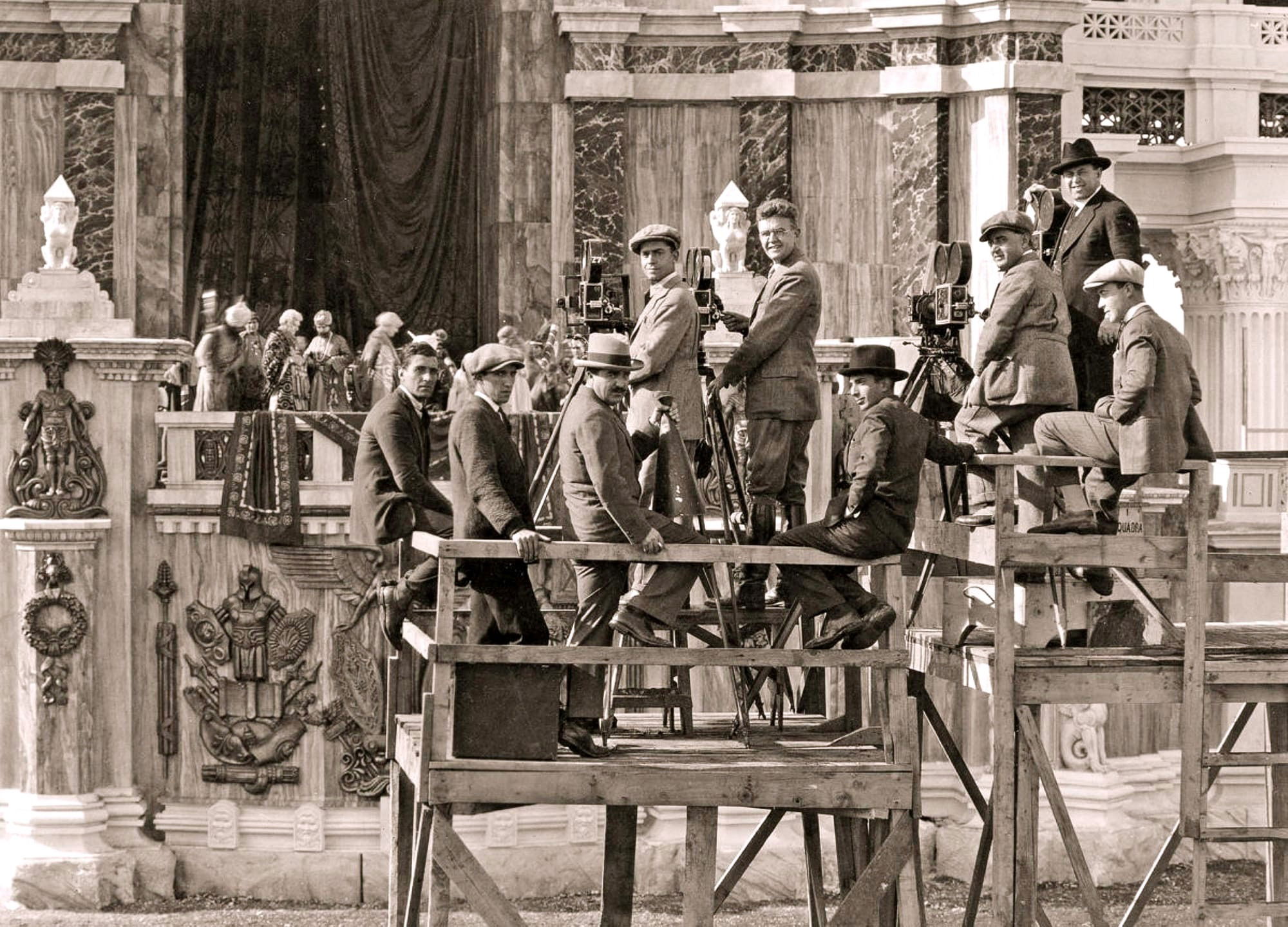
A Journey Between Greatness and Innovation
The first decades of the twentieth century witnessed an artistic and technological revolution in the world of cinema. With the advent of the "colossal", the big screen was transformed into a canvas on which to paint stories of epic proportions. These films, often based on historical or mythological events, required large casts, elaborate sets and unprecedented budgets. The creation of these monumental works was not only a display of greatness, but also a daring exploration of the narrative and visual potential of the cinematic medium.
The term "colossal" conjures up images of massive sets and mass scenes involving thousands of extras. Films such as D.W. Griffith's "Intolerance" and Cecil B. DeMille's "Cleopatra" set new standards for film production. These pioneers of cinema harnessed their ambitious visions to create immersive experiences, transporting viewers to distant eras and worlds. The greatness of these productions lay not only in the physical scale, but also in the ambition to tell universal stories that resonated with audiences of all times.
The construction of a "colossal" was a colossal undertaking in itself. Every aspect of the production, from script to post-production, required an unprecedented level of detail and precision. Set and costume designers worked tirelessly to recreate historical settings with authenticity and accuracy. The directors of these films were true orchestra masters, directing cast and crew in complex scenes that often included grandiose battles and intricate court ballets.
These films not only entertained, but educated and inspired. Through the representation of historical events and legends, the "colossal" offered the public a window into the past and the cultural heritage of humanity. They were vehicles of values and ideals, reflecting the aspirations and fears of an era. In a time marked by social and political change, these films provided a sense of continuity and a connection to common roots.
The legacy of the "colossal" of cinema is long-lasting. They paved the way for future generations of filmmakers, proving that cinema is an art without limits. Their influence extends far beyond the confines of the big screen, influencing popular culture, fashion, and even architecture. Their grandeur continues to be a source of inspiration for storytellers around the world, reminding us that cinema is a powerful tool for telling stories that can change the world.
Cabiria: The First Colossal in the History of Cinema
Introduction
Before diving into the epic world of Ben-Hur: A Tale of the Christ of 1925, and other epic Colossals it is essential to explore another masterpiece that has marked the history of cinema: Cabiria. This 1914 film, directed by Giovanni Pastrone, is often considered the first true cinematic blockbuster. Although there are no cigarette cards dedicated to Cabiria, its historical and cultural importance makes it a perfect introduction to our journey through the great epic films.
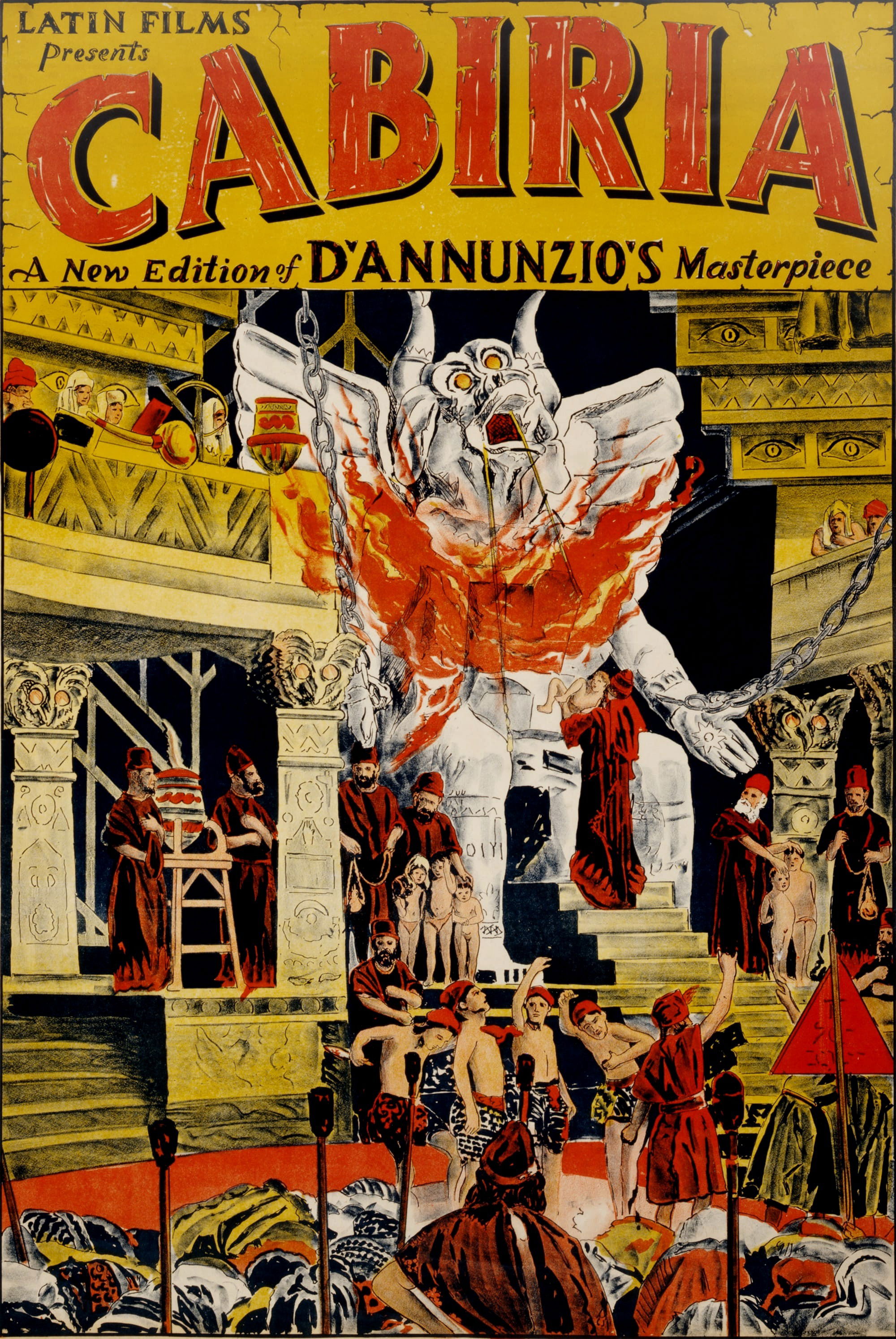
Movie Poster
Production and Technical Innovations
Cabiria was a monumental production for the time. Shot in Itala Film's studios in Turin and in various locations such as Tunisia, Sicily and the Alps, the film had a budget of around one million lire, making it the most expensive Italian film of its time. One of the most significant technical innovations introduced by Cabiria was the use of the "tracking shot", a shooting technique that allows the camera to move fluidly through the scenes, creating a dynamic and engaging visual effect.
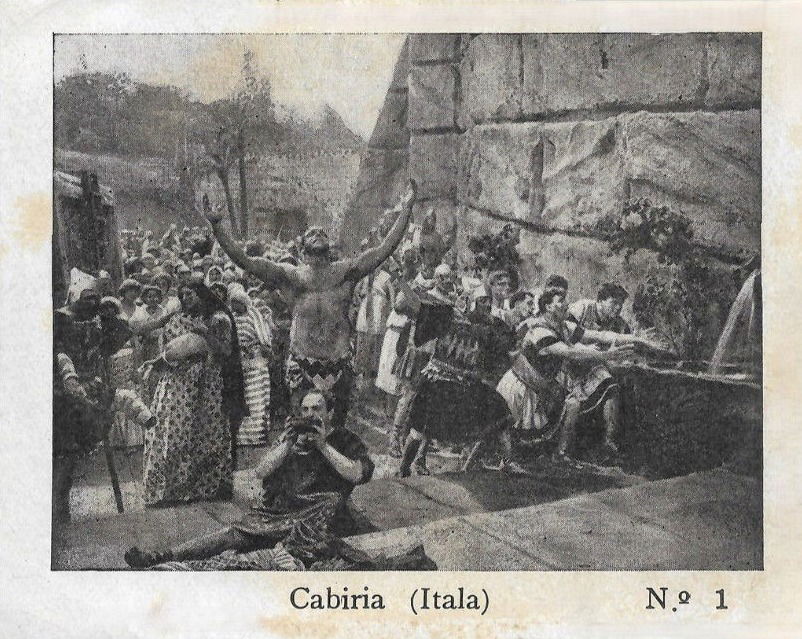
card n.1 Chocolate Amatller, Barcelona
Plot and Themes
The plot of Cabiria is set during the Second Punic War and follows the adventures of a young girl, Cabiria, kidnapped by pirates and sold as a slave. The story intertwines historical events and fictional characters, offering an epic narrative that spans the Mediterranean and Africa. The main themes include the struggle for freedom, courage and human resilience.
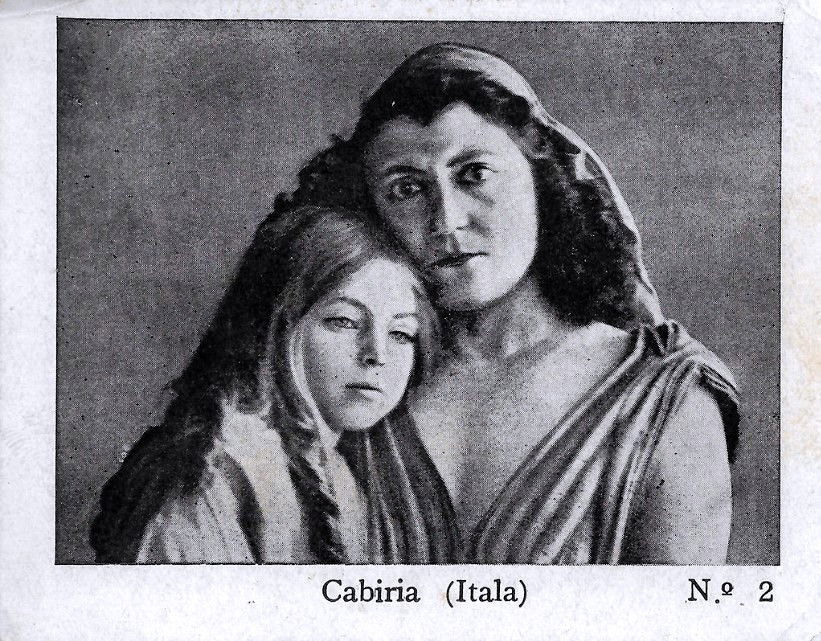
card n.2 Chocolate Amatller, Barcelona
Collaboration with Gabriele D'Annunzio
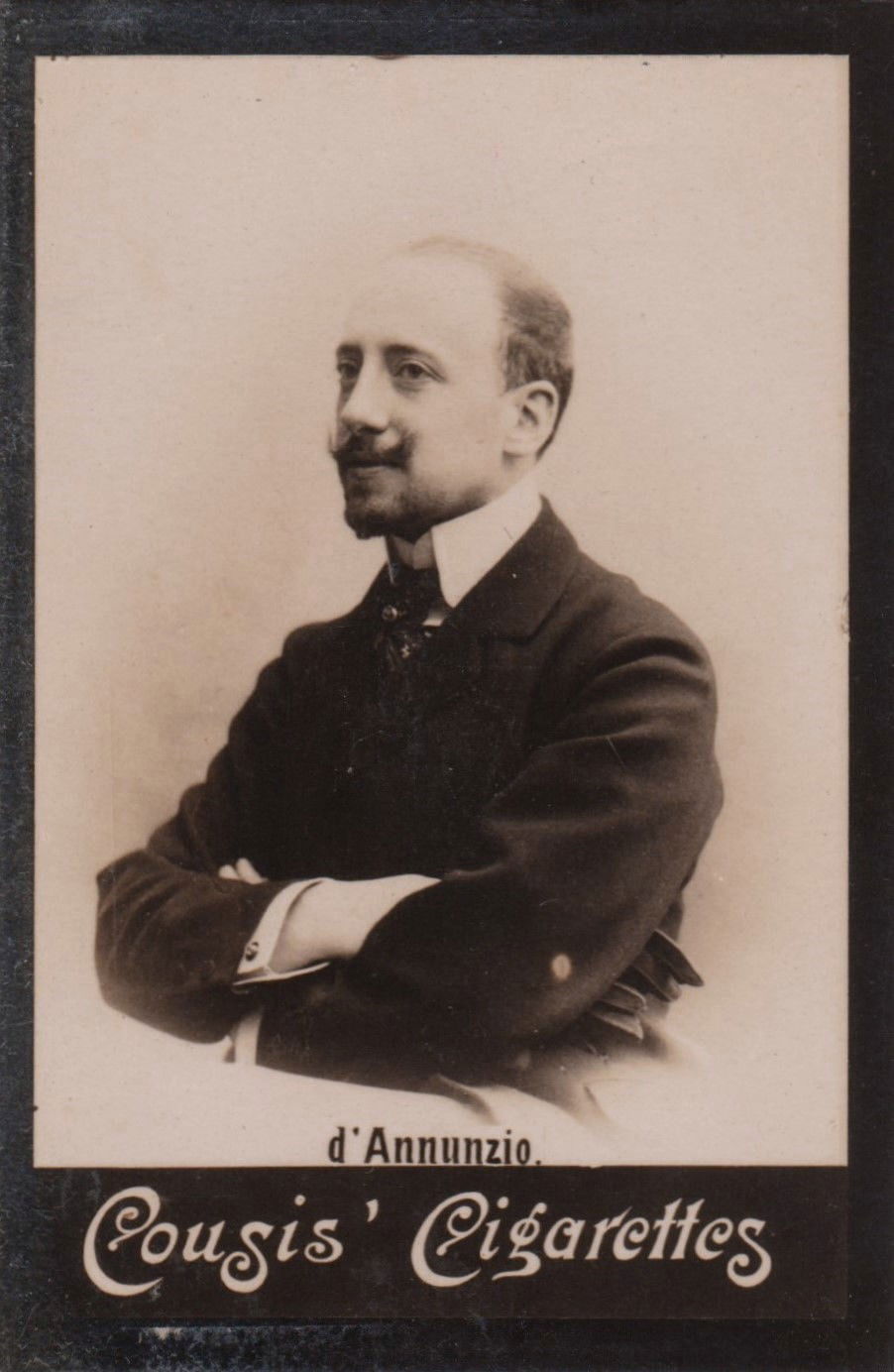
COUSIS' CIGARETTES serie "Celebrities"
(personal collection)
Another distinctive element of Cabiria is the collaboration with the famous poet and writer Gabriele D'Annunzio, who wrote the intertitles of the film. This gave the film a literary and solemn tone, elevating its artistic level and helping to create a work of great cultural impact.
Cultural and Historical Impact
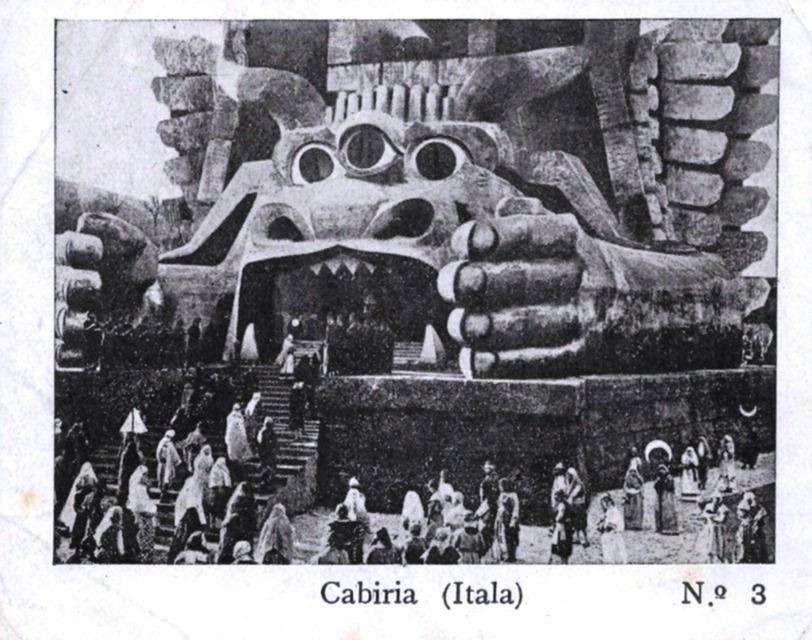
card n.3 Chocolate Amatller, Barcelona
Cabiria not only set new standards for film productions, but also demonstrated the potential of cinema as an art form capable of telling stories on a large scale. The film was the first to be screened at the White House and profoundly influenced subsequent epic cinema, both in Italy and abroad. His legacy is evident in many epic films that followed, including subsequent Hollywood blockbusters.
Critical Analysis
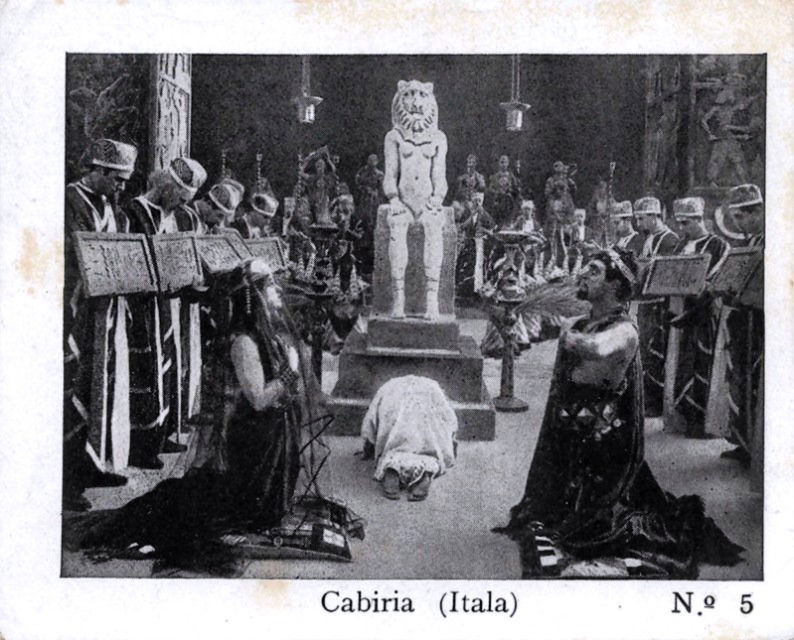
card n.5 Chocolate Amatller, Barcelona
The film "Cabiria" represents a challenge for contemporary audiences, more so than other silent works to which he has provided inspiration, both directly and indirectly. However, it is studded with sequences that leave the viewer in admiration for the cinematic mastery on display. Even in his most tense scenes, his tangibility and immediate stage presence are such as to arouse wonder that all this has really been accomplished, despite the difficulties, prudence and restraint. With its intricate web of grandeur and aspirations, "Cabiria" remains unsurpassed, even after a century or more.
Conclusion
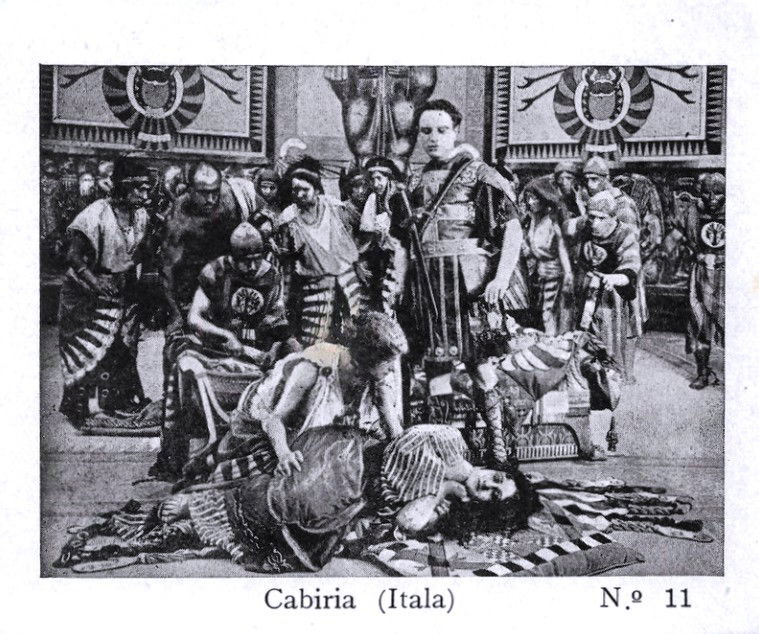
card n.11 Chocolate Amatller, Barcelona
Cabiria represents a turning point in the history of cinema, a work that has been able to combine technical innovation, epic storytelling and a high artistic level. Although there are no cigarette cards dedicated to this film, its historical importance makes it an essential introduction to understanding the evolution of epic films and colossals. Before exploring 1925's Ben-Hur: A Tale of the Christ, it's crucial to recognize Cabiria's lasting impact and its pioneering role in cinema.
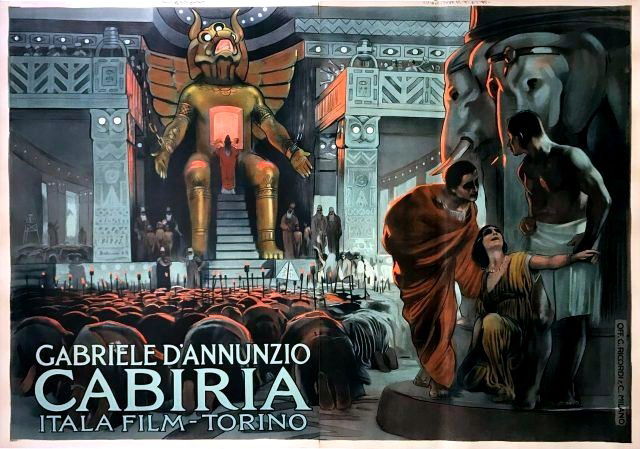
BEN-HUR - A TALE OF THE CHRIST (1925)
Movie poster
Directed by Fred Niblo and produced by Metro-Goldwyn-Mayer (MGM), Ben-Hur: A Tale of the Christ is one of the most iconic films in silent cinema. With a budget of over $3.9 million, the film is known for its grandeur and technical innovation, including the pioneering use of Technicolor in some sequences. The plot follows the story of Judas Ben-Hur, a Jewish prince betrayed by his childhood friend Messala, and culminates in the famous chariot race, one of the most spectacular sequences in silent cinema.
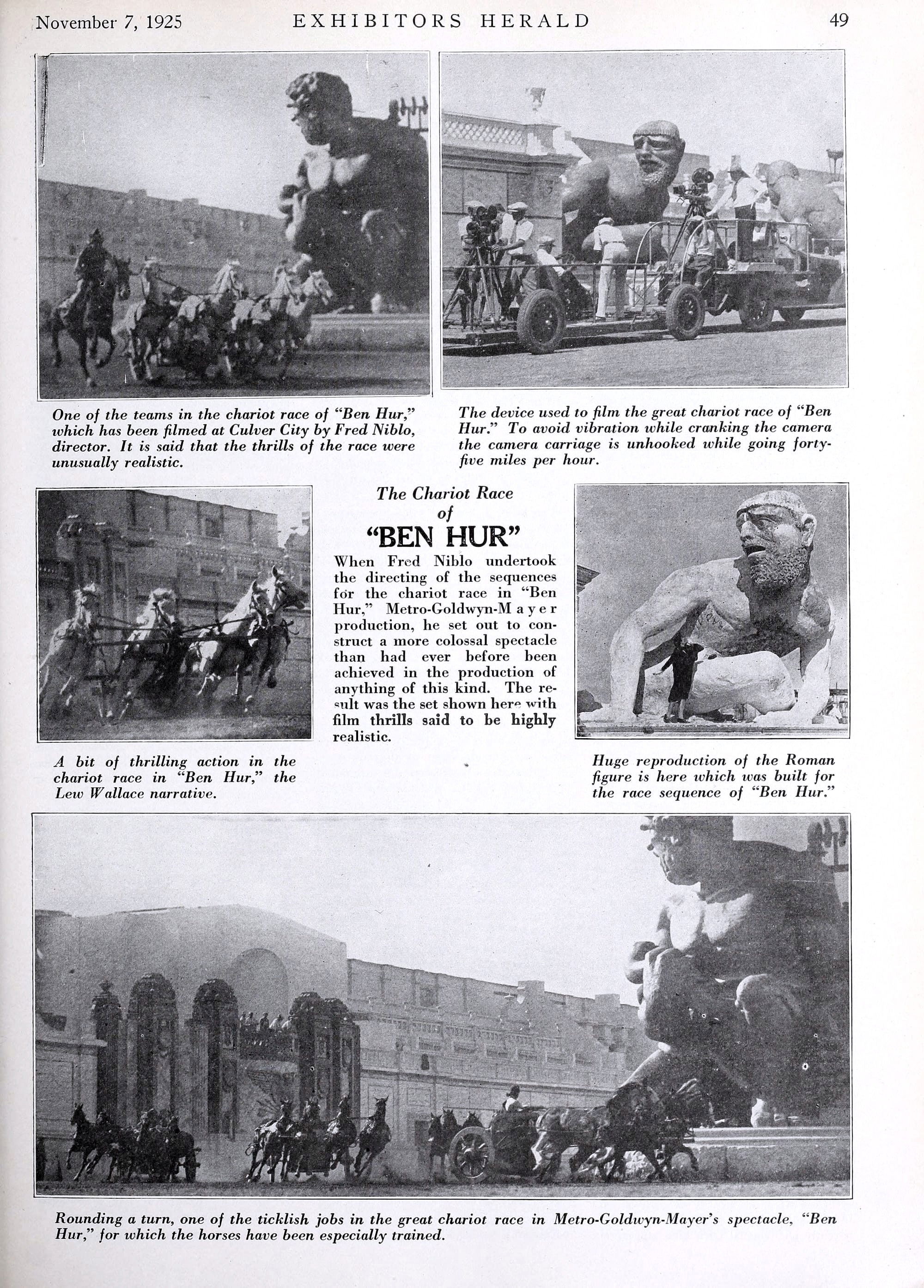
"Courtesy of the Media History Digital Library"
Exhibitors Herald (November 7, 1925)
Historical Context and Production:
In the early 1920s, the American film industry was going through a period of great transformation and growth. The merger of Metro Pictures, Goldwyn Pictures, and Louis B. Mayer Pictures in 1924 led to the creation of Metro-Goldwyn-Mayer (MGM), one of Hollywood's most influential film studios. This new conglomerate was looking to establish itself with ambitious and visually striking productions, and Ben-Hur was the perfect opportunity to demonstrate its capabilities.
The production of Ben-Hur was one of the most complex and expensive of the time. Initially, the direction was entrusted to Charles Brabin, with the intention of shooting most of the film in Italy. However, the logistical and political difficulties encountered during filming led to a stagnation of the project. Filming began in 1923, but after six months, production was seriously delayed and costs were rising without satisfactory results.
MGM's new management, consisting of Marcus Loew, Louis B. Mayer, Harry Rapf, and Irving Thalberg, decided to make drastic changes. The direction passed to Fred Niblo, and many scenes were reshot to improve the quality of the film. Filming took place in several locations, including Anzio, Livorno and Rome in Italy, and in California, at MGM studios in Culver City and at Iverson Ranch in Chatsworth.
THE CAST
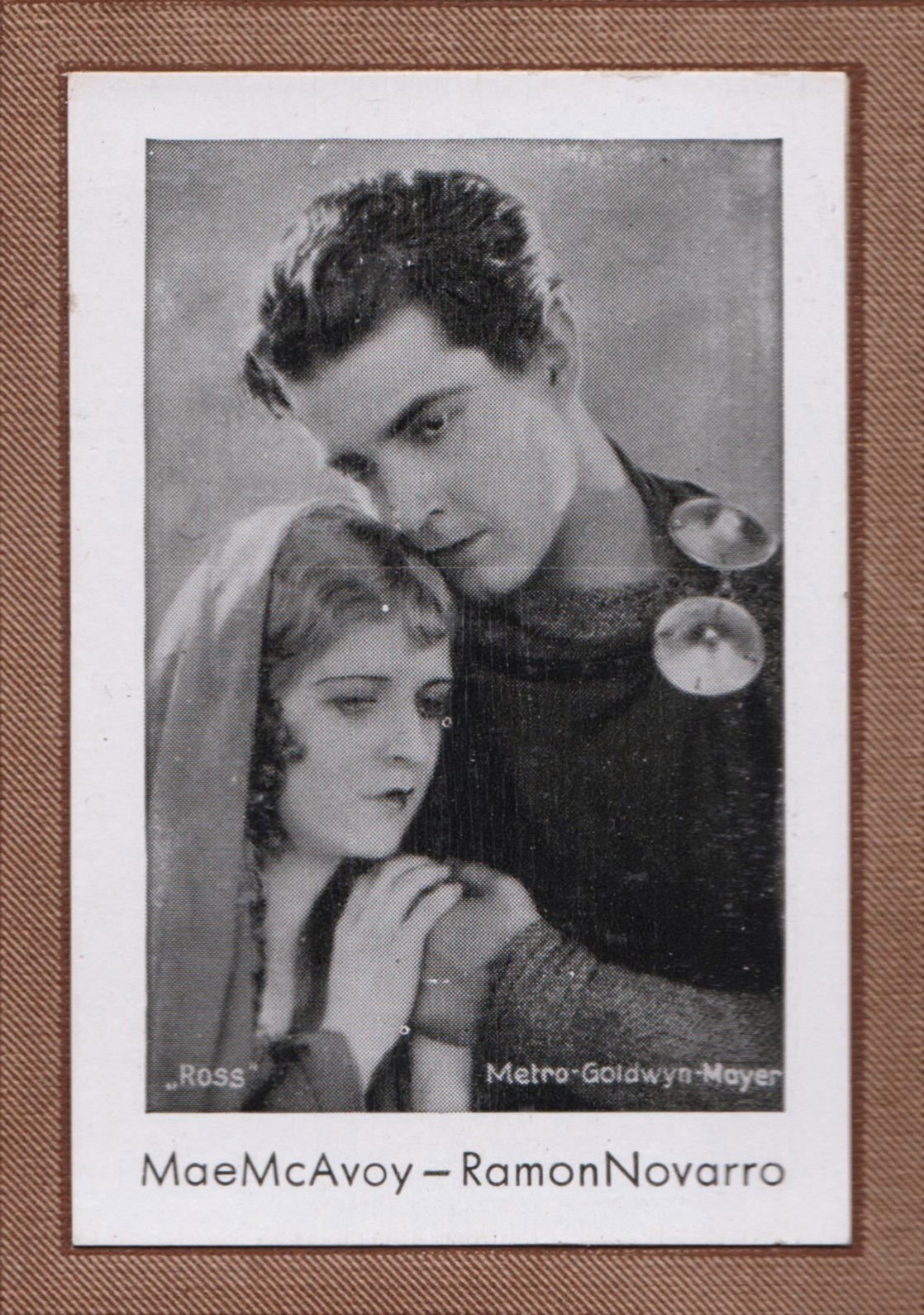
Card position 2 pag. 29
JOSETTI FILM ALBUM N°2
(personal collection)

The choice of the protagonist for the 1925 film "Ben-Hur" is an interesting example of how film production dynamics and casting decisions can influence the final result of a work. Initially, the role of Ben-Hur was entrusted to George Walsh, an actor who enjoyed a certain notoriety at the time and who seemed the ideal choice to play the main character of this epic story. However, the production of the film underwent a significant change when Fred Niblo took over as director, bringing with it a new vision for the film and for the character of Ben-Hur.
Niblo, evaluating the options available to him, decided that Ramón Novarro was the most suitable actor to embody the role of the Jewish nobleman. Novarro, of Mexican origin, had already demonstrated his talent and charisma in previous productions, and his stage presence was considered ideal for a film of such magnitude. His choice was also influenced by the desire to differentiate himself from the theatrical version of "Ben-Hur" and to offer the audience a new and fascinating face.
Rudolph Valentino, another big name in silent cinema, had also been considered for the role. Valentino, known for his exotic appearance and his ability to attract female audiences, could have brought considerable media attention to the film. However, for reasons that remain the subject of speculation, he was not chosen. Some argue that his image was too tied to seductive roles and that this could conflict with Ben-Hur's more austere and moral image.
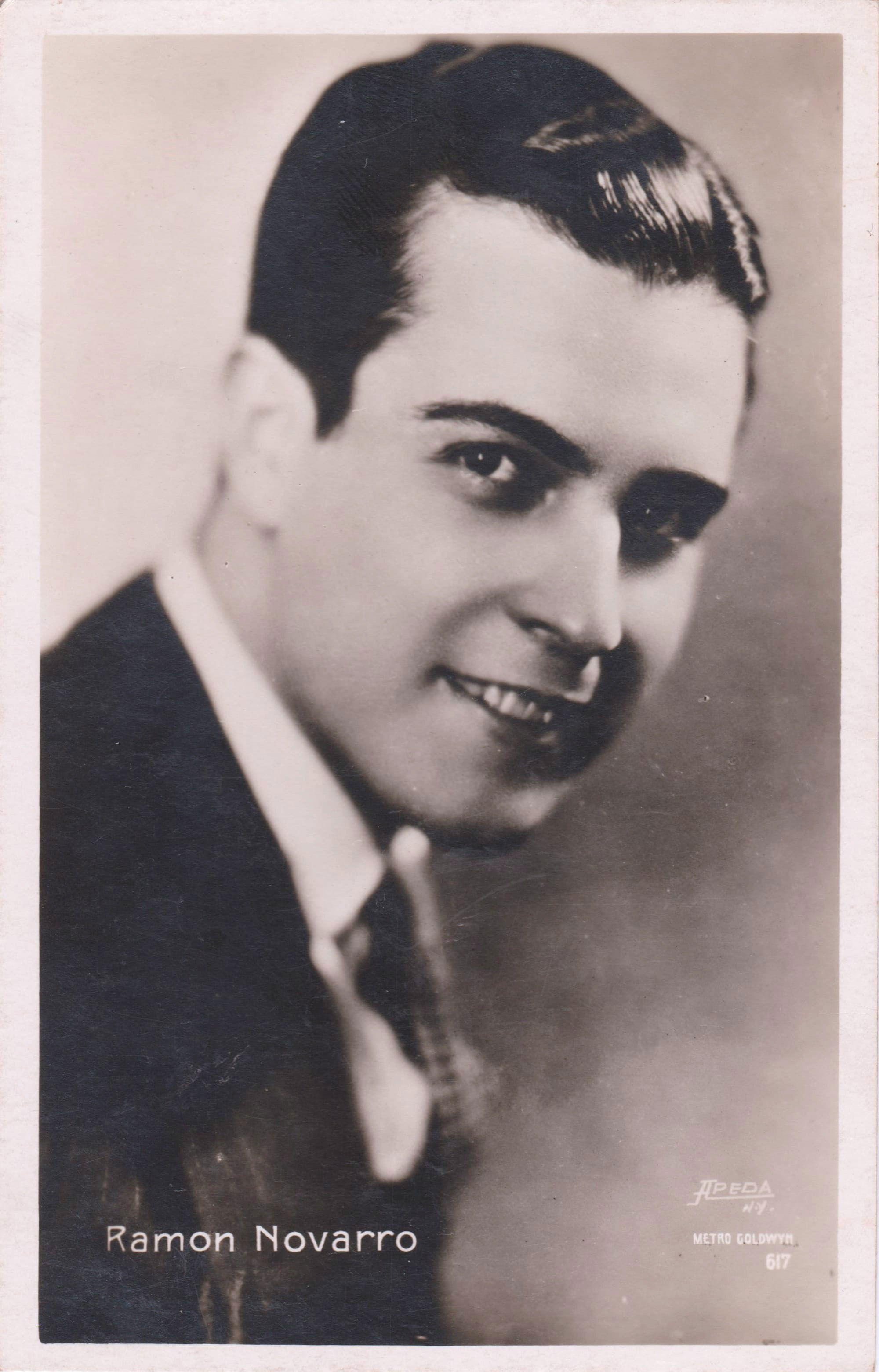
Postcard n.617 G. Vettori Bologna
(personal collection)
The final decision to choose Novarro for the role of Ben-Hur proved to be acute. His performance was praised by critics and audiences alike, contributing to the success of the film, which became one of the greatest successes of silent cinema.


Card n.6 pag. 2 SALEM GOLD FILM PICTURES ALBUM 1
(personal collection)
Novarro's performance added depth and humanity to the character, making the story of "Ben-Hur" even more engaging and memorable.
Ultimately, the choice of the cast for "Ben-Hur" reflects the importance of a careful selection process of actors, which must take into account not only their acting skills, but also the way in which they fit into the overall vision of the film and its reception by the public. The story behind the casting of "Ben-Hur" remains a prime example of how decisions made behind the scenes can have a lasting impact on a film's legacy.
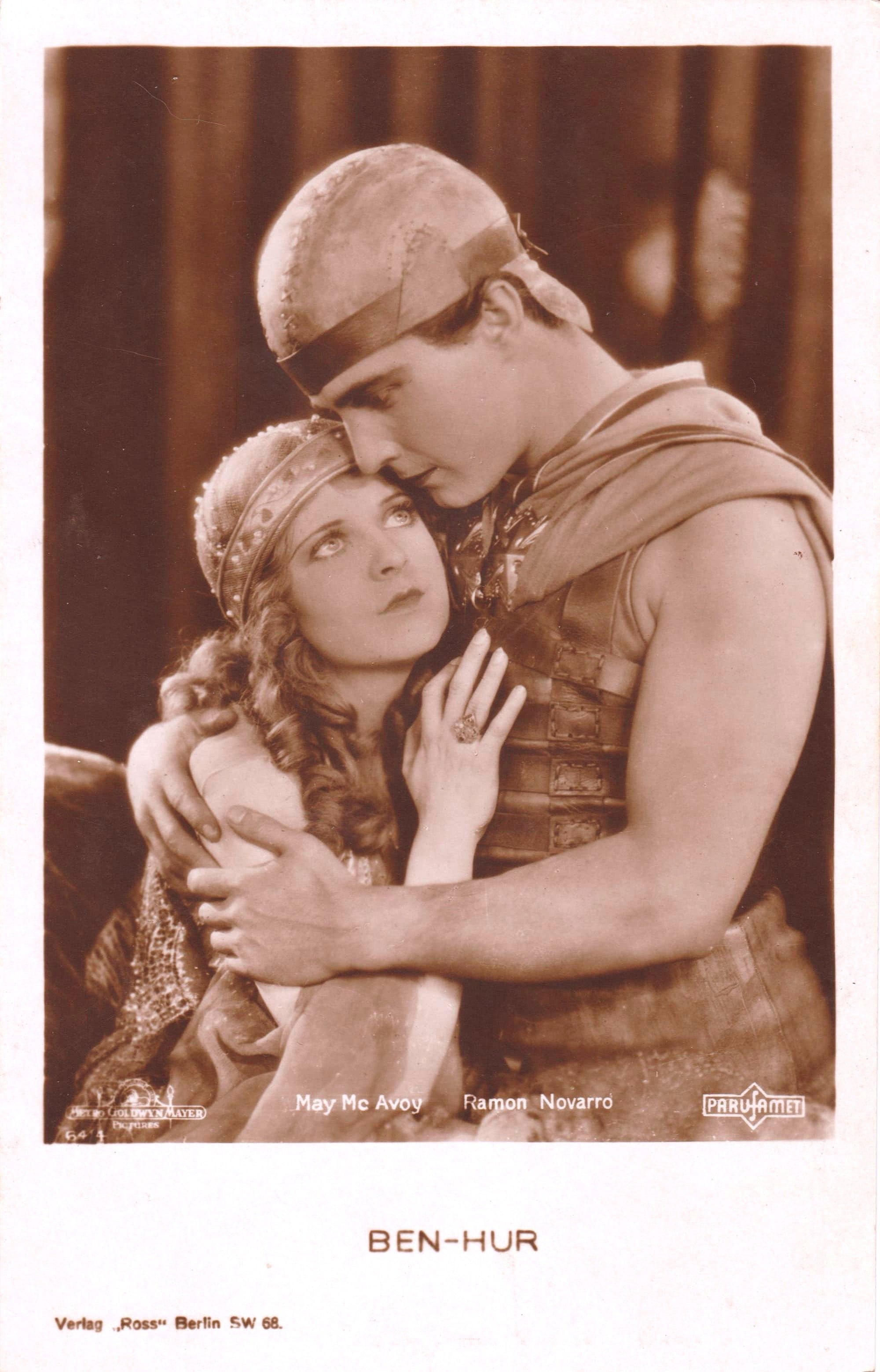
Verlag "ROSS" Berlin SW 68
exclusive sale Ballerini and Fratini Publishing House -Florence
(personal collection)
The cast of the 1925 film "Ben-Hur: A Tale of the Christ" represents a fascinating mosaic of talent from the silent film era. Directed by Fred Niblo and with the uncredited participation of other directors such as Charles Brabin and Christy Cabanne, the film is a milestone in the history of cinema.
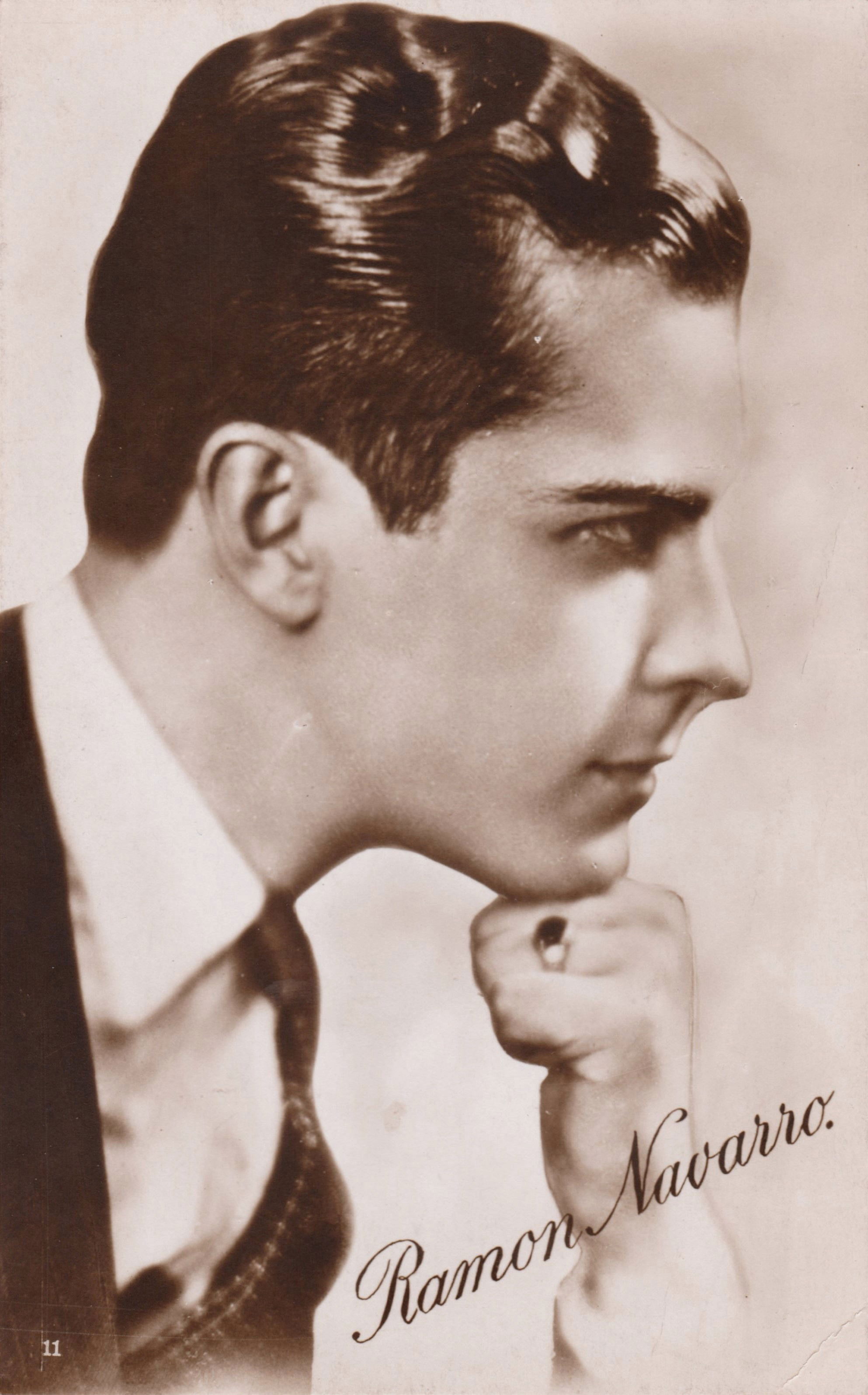
POST CARD n° 33 "CINEMA STARS" Series 1 (1930)
PRINTED by SARONY Cigarettes
(personal collection)
Ramon Novarro, in the title role of Judah Ben-Hur, gave a memorable performance that still resonates with the audience today for its emotional intensity and stage presence.
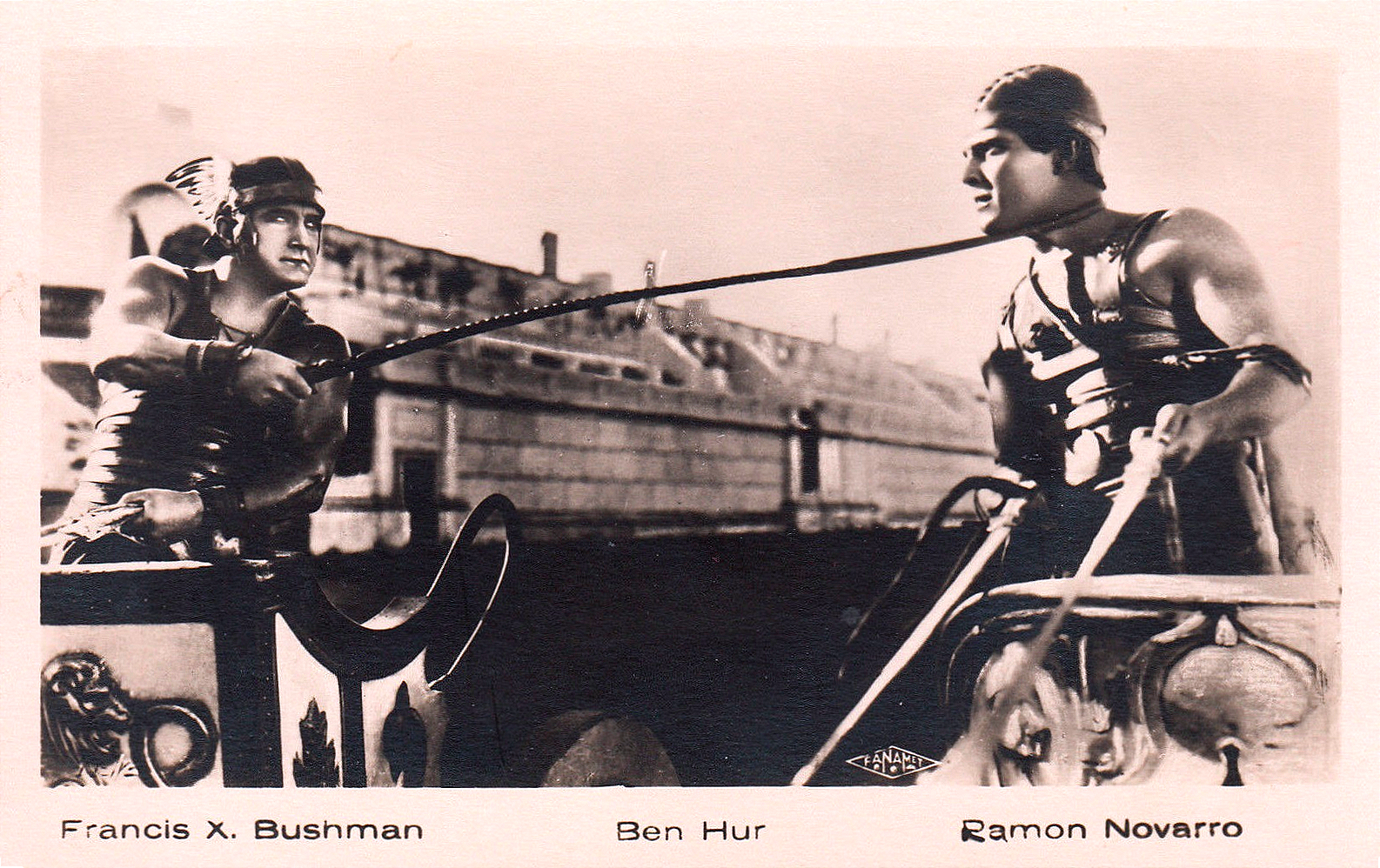
Iris 6291 FRANCIS X.BUSHMAN & RAMON NOVARRO
Francis X. Bushman, playing the role of Messala, provided a perfect counterpoint with his depiction of betrayal and ambition.
POST CARD n° 34 "CINEMA STARS" Series 1 (1930)
PRINTED by SARONY Cigarettes
(personal collection)
May McAvoy, as Esther, brought a sweetness and sensitivity that balanced the drama and action of the film.
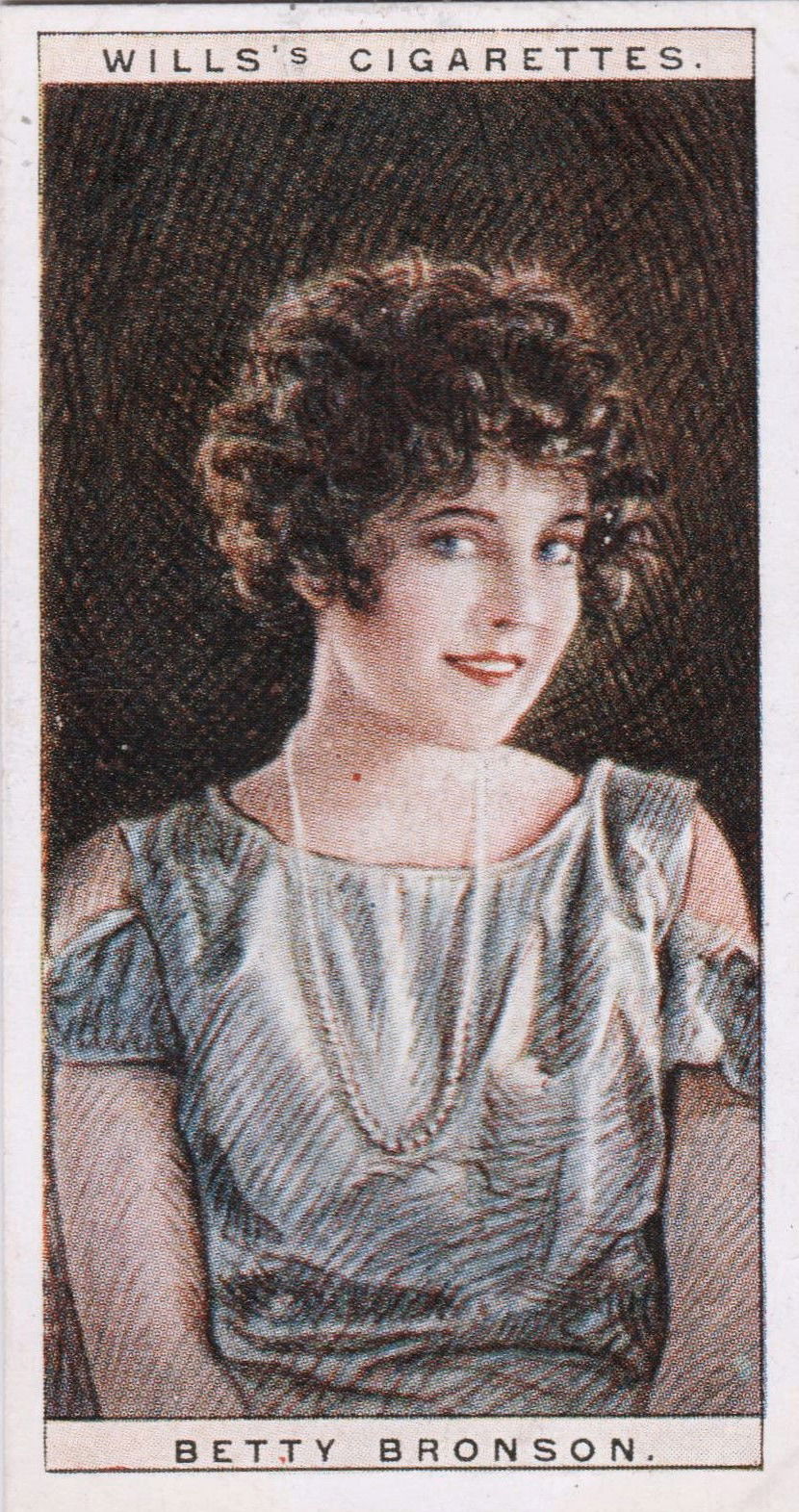
Sticker n.6 of the CINEMA STARS 2nd SERIES series
printed by W.D. & H.O. WILLS in 1928
(personal collection)
Betty Bronson, like Mary, gracefully embodied the maternal figure that is central to the Christian narrative.

Sticker n.43 of the CINEMA STARS series
printed by GALLAHER LTD in (1926)
(personal collection)
Carmel Myers, playing Iras, added a touch of exoticism and mystery, while Claire McDowell, as the Princess of Hur, offered a representation of dignity and strength. Kathleen Key, as Tirzah, captured the innocence and suffering of a character tragically affected by circumstances. Nigel De Brulier, in the role of Simonides, delivered a solid and convincing performance.
The film is also known for its stellar supporting cast, which included names such as Mitchell Lewis, Leo White, Frank Currier, and Charles Belcher. Each actor contributed their own uniqueness to the narrative fabric of the film, making it a complex and layered work. The production of the film was a colossal undertaking, with a budget that at the time was the highest ever recorded for a silent film, and the result was an unprecedented cinematic experience that left its mark on the history of cinema.
The film has been selected for preservation in the National Film Registry of the Library of Congress of the United States, recognizing its cultural, historical and aesthetic significance. This recognition underscores the importance of "Ben-Hur" as a masterpiece that has influenced generations of filmmakers and film enthusiasts. His legacy continues to be celebrated and studied, and the 1925 cast remains a shining example of the art of silent filmmaking.
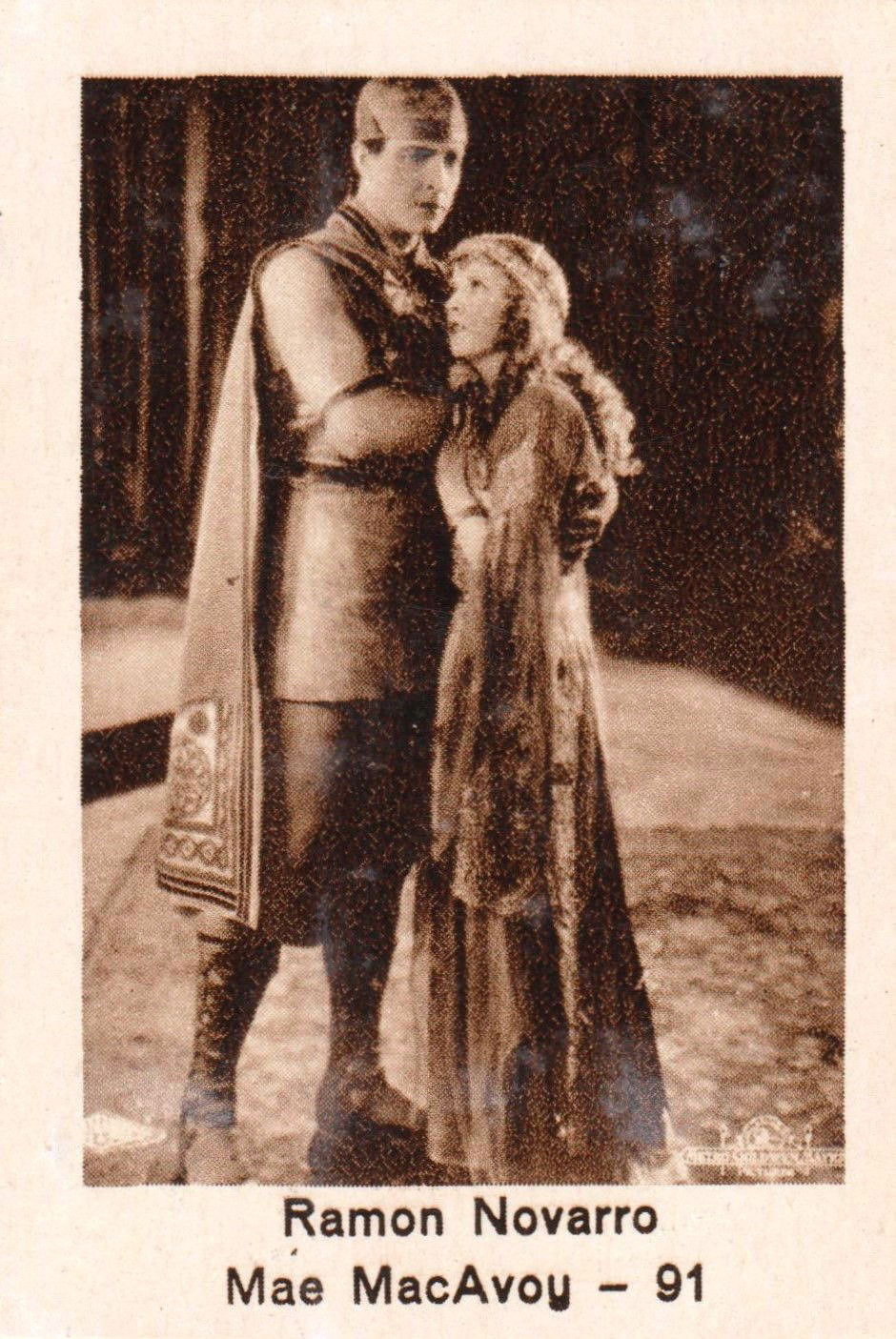

Card n.91 dell'Album MONOPOLY FILM-PICTURES
(personal collection)
Technical Innovations
One of the film's most significant innovations was the use of Technicolor in certain sequences, a pioneering technology for the time. This added a touch of visual vibrancy in an era dominated by black and white.
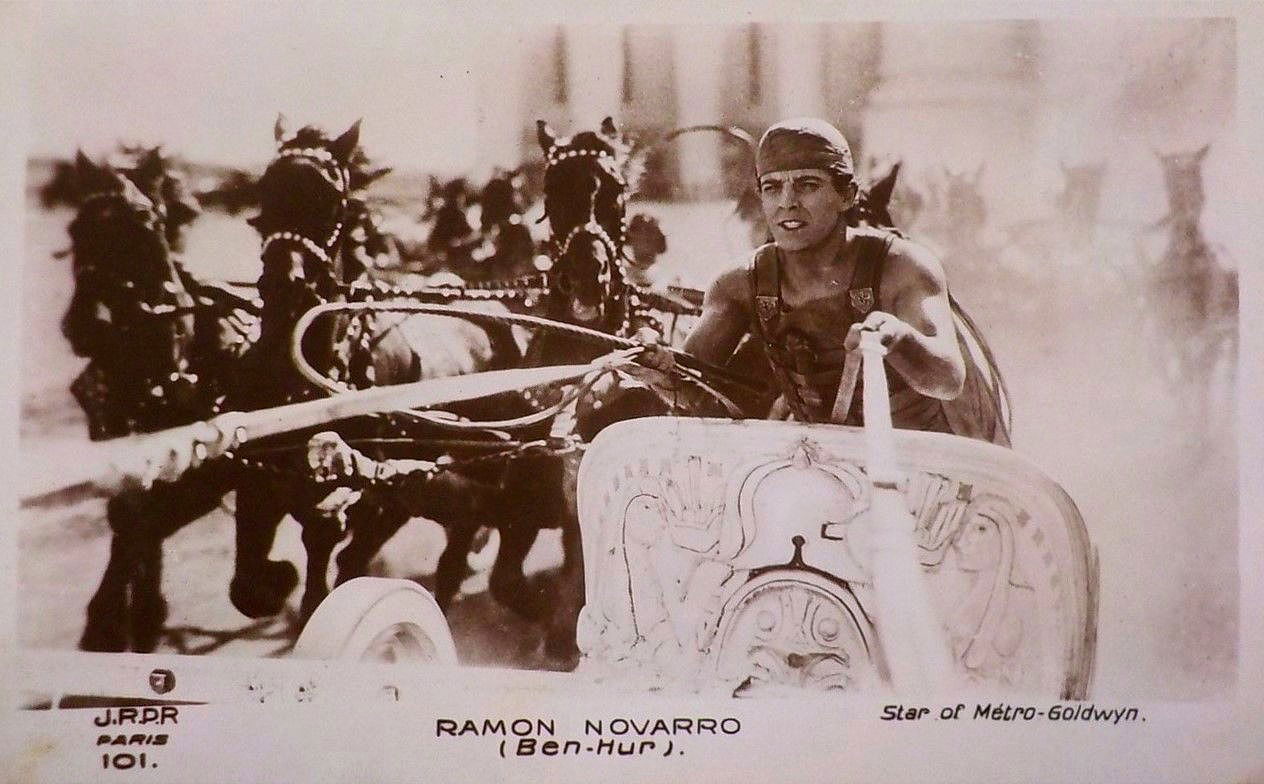
JRPR 101 (PARIS) RAMON NOVARRO
The chariot race scene, in particular, is considered one of the most spectacular and well-crafted sequences in silent cinema, thanks to its advanced special effects and grandiose sets.
Impact and Recognition
Despite the initial difficulties, Ben-Hur was a huge commercial and critical success. The film cemented MGM's reputation as one of Hollywood's most important film studios and set new standards for epic films. In 1997, Ben-Hur: A Tale of the Christ was chosen to be preserved in the National Film Registry of the United States Library of Congress for its cultural, historical, and aesthetic importance.
This historical context and Ben-Hur's complex production demonstrate how the film industry of the time was able to overcome significant challenges to create works of great visual and narrative impact.
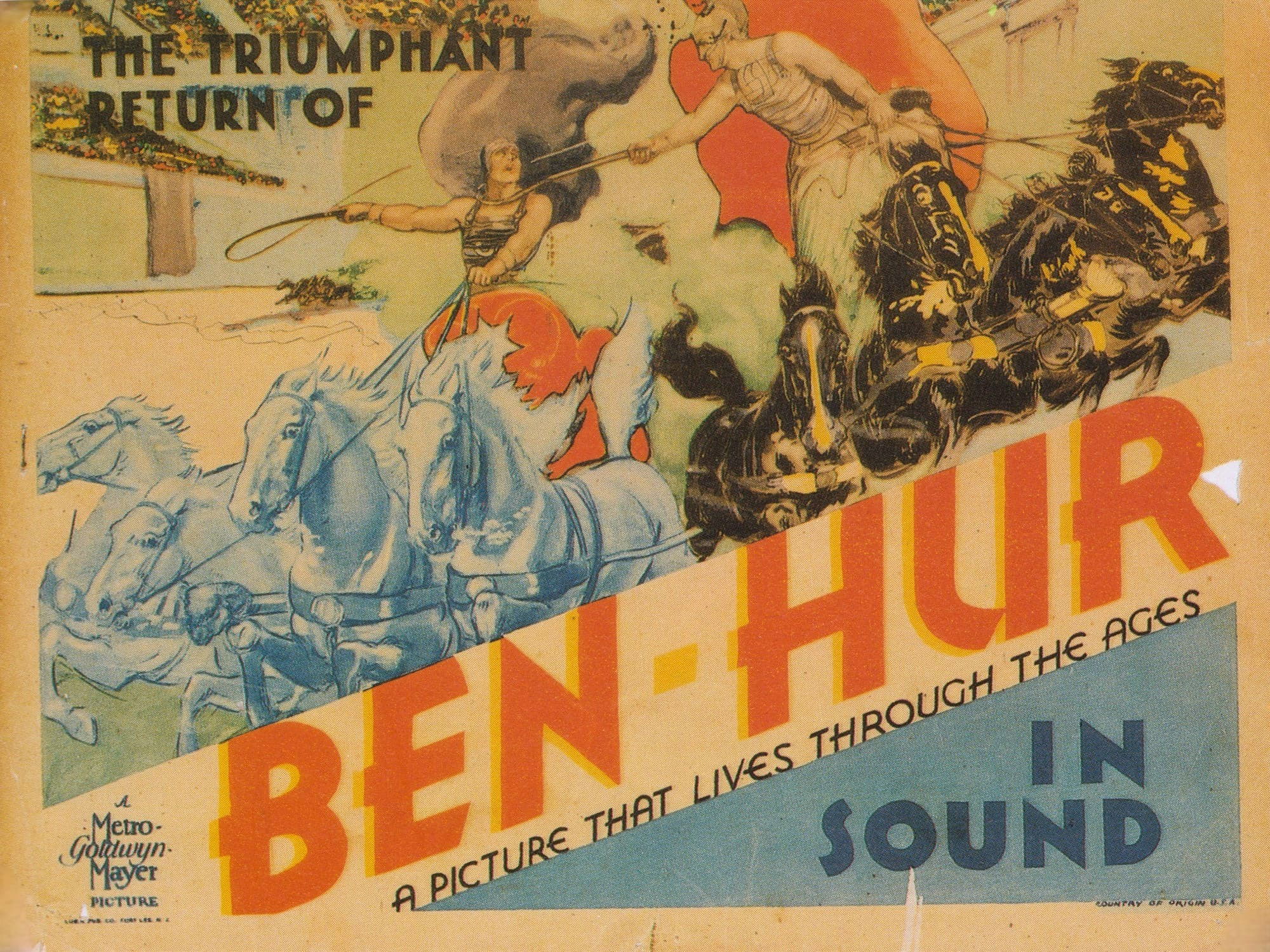
US LOBBY CARD (1925)
The lobby cards of "Ben-Hur" from 1925 are not only precious film memorabilia, but also fascinating windows into the past that capture the visual and artistic essence of a bygone era of cinema. These cards, often featuring vivid illustrations and key moments in the narrative, were essential promotional tools for cinemas of the time, used to create anticipation and interest among audiences. The chariot race, in particular, is one of the most memorable scenes and often depicted in lobby cards, reflecting the emotion and drama that the film conveyed.
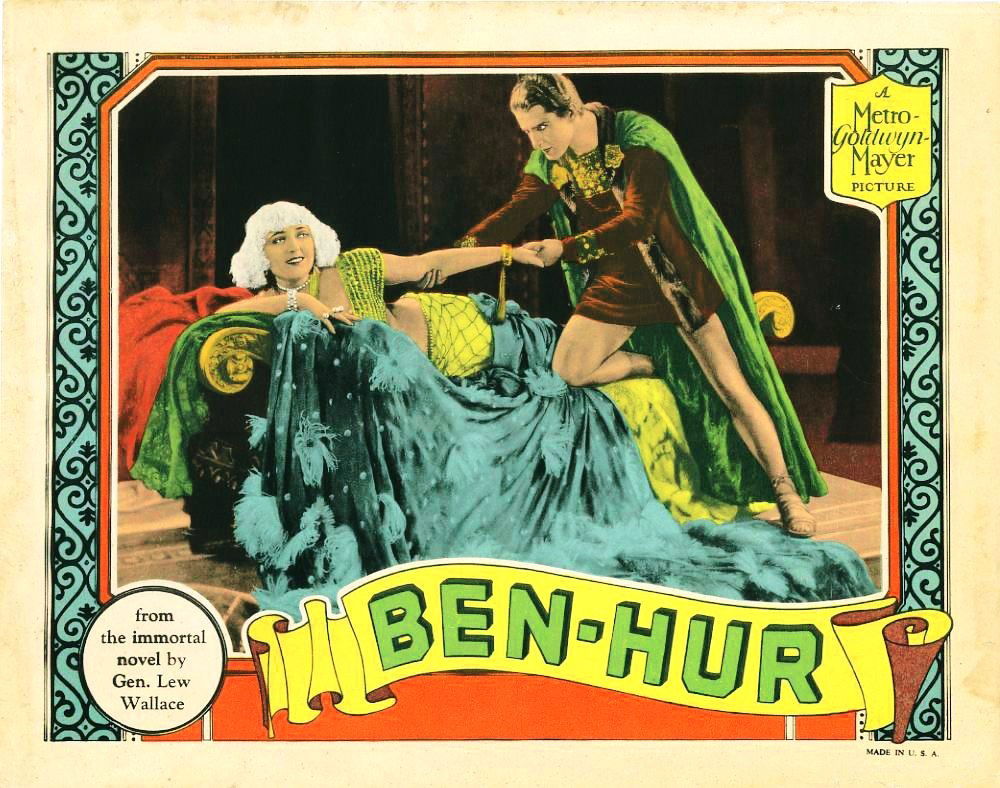
US LOBBY CARD (1925)
CLEOPATRA
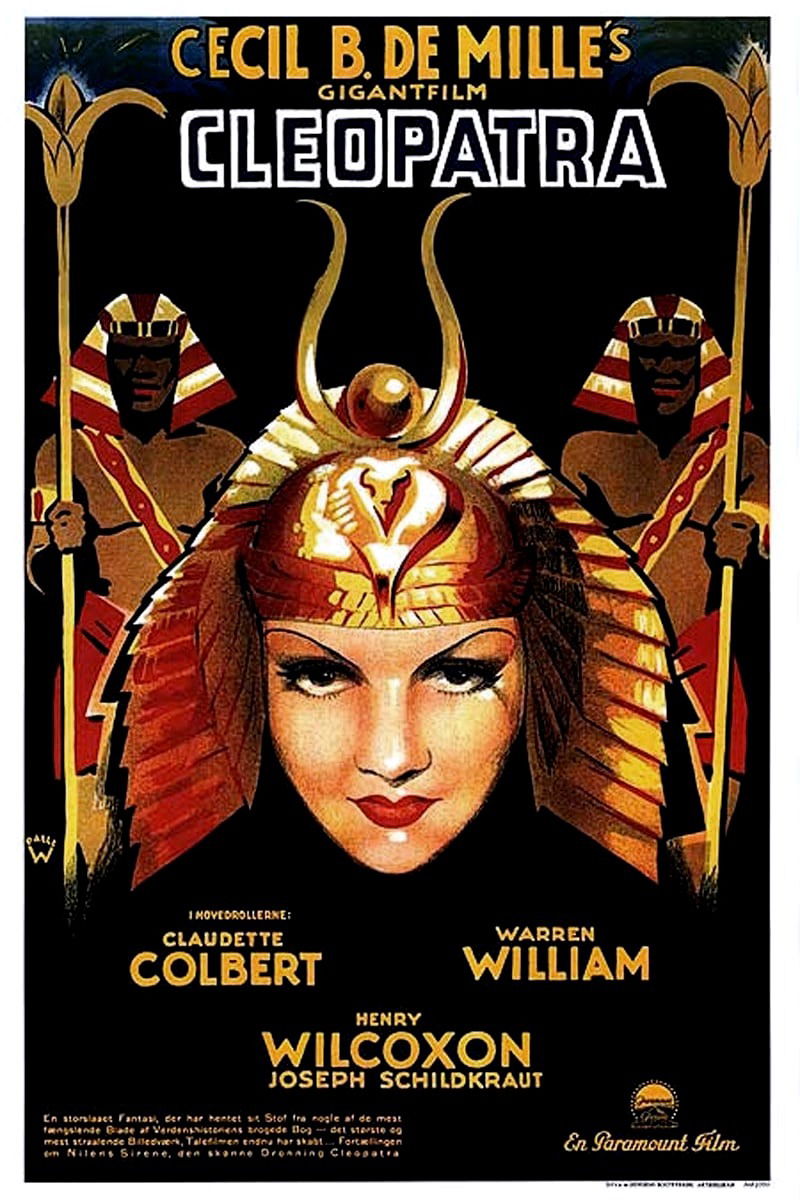
German poster of the film
The 1934 film "Cleopatra", directed by the visionary Cecil B. DeMille and starring the charismatic Claudette Colbert, represents an emblematic example of the blockbuster film genre, which marked the golden age of Hollywood. This production, known for its magnificence and elaborate sets, embodies the quintessential epic cinema that aimed to amaze and entertain audiences with grandiose depictions of historical events.
DeMille's choice to bring Cleopatra's life to the big screen is part of a broader context of fascination with ancient Egypt, which influenced not only cinema, but also fashion, architecture and the arts during the 20s and 30s.
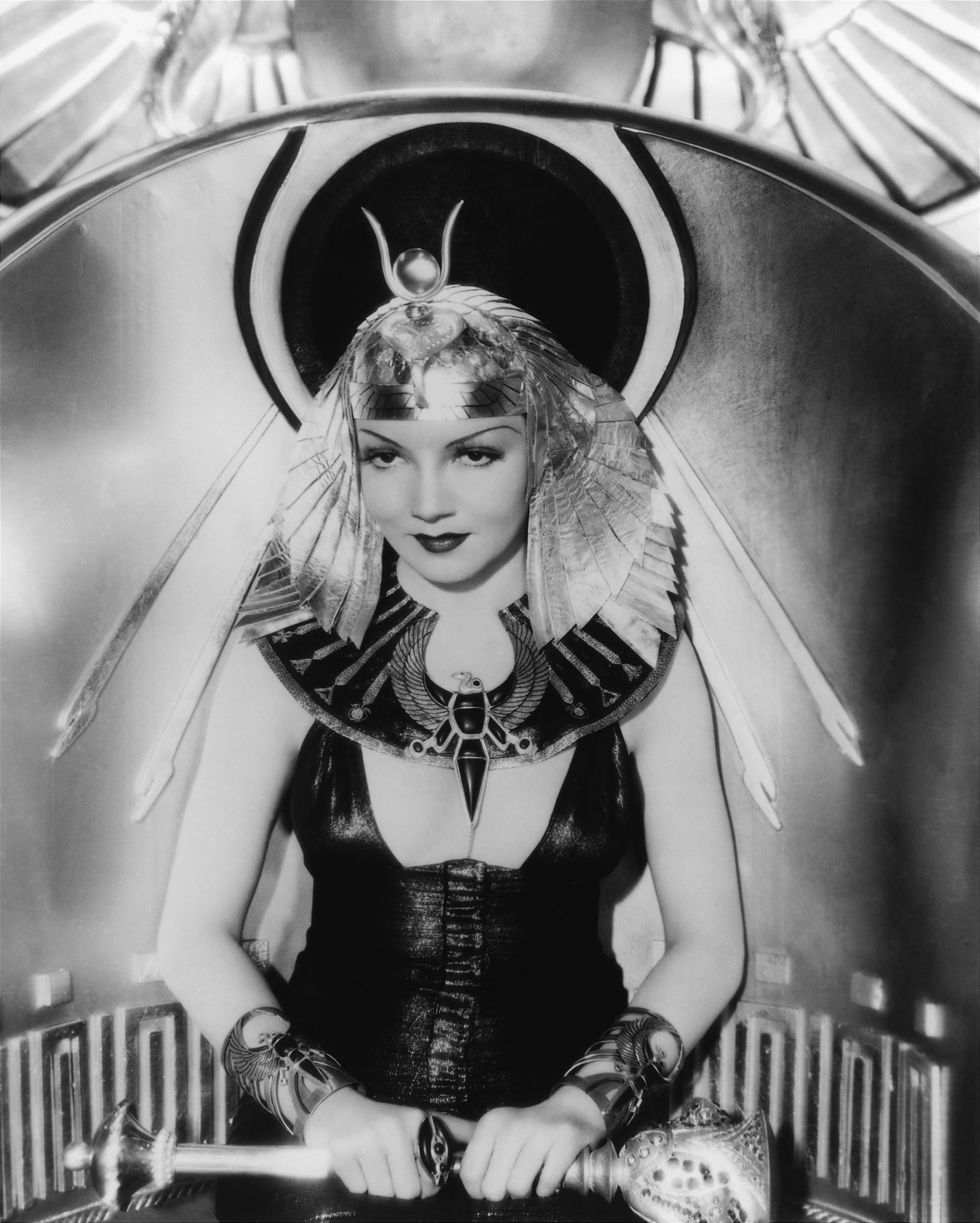
Scene from the Movie
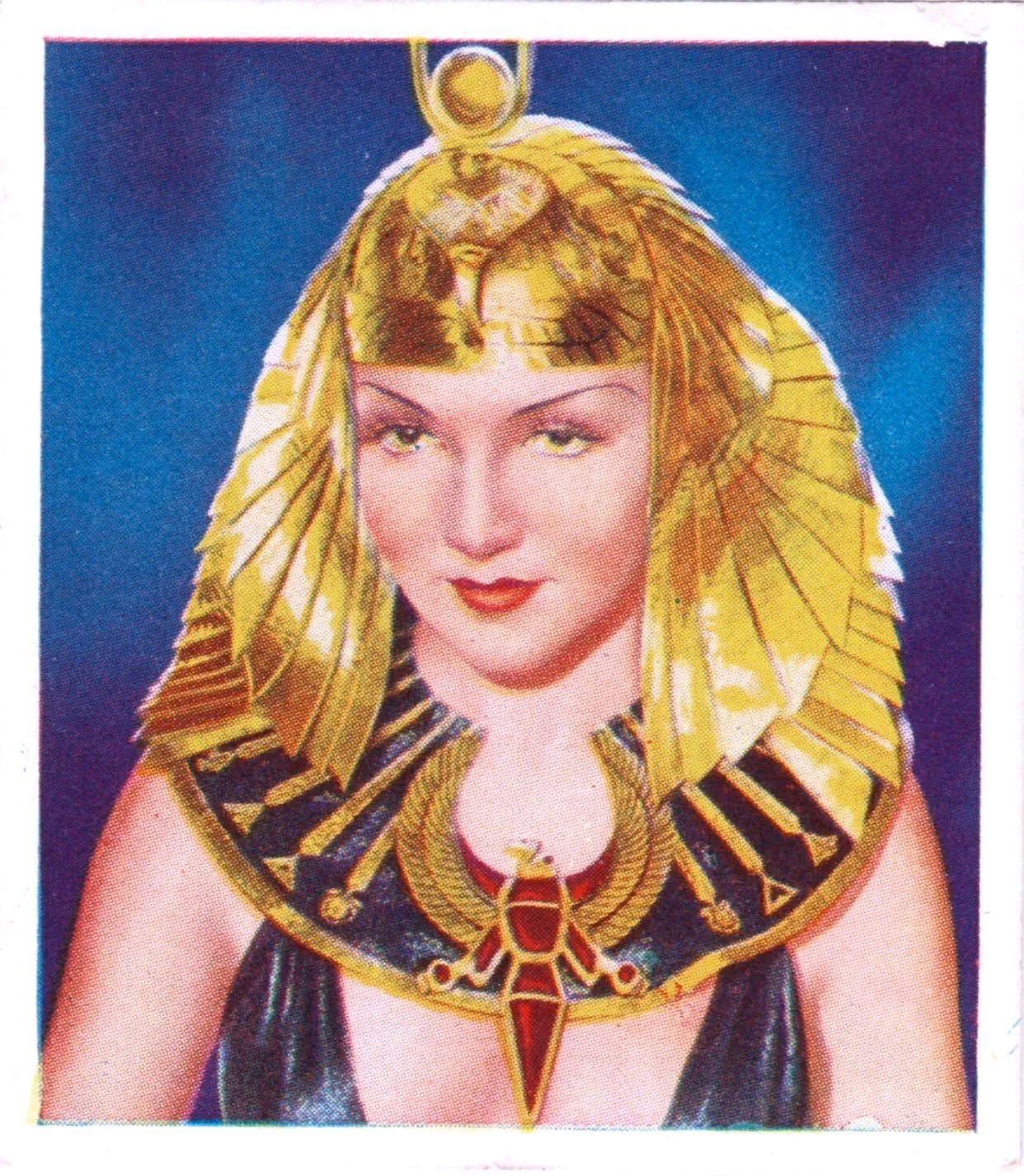
Card n.6 della serie CHARACTERS COME TO LIFE
GODFREY PHILLIPS LTD nel 1938
(personal collection)
Colbert's depiction of Cleopatra was acclaimed for its strength and nuance, offering a vision of the Egyptian queen who, despite being a product of her era, was able to transcend time to become a cultural icon.
The film's success can be attributed not only to the actors' performance and majestic direction, but also to the innovative use of cinematic techniques, such as special effects and costume design, which helped to create an unparalleled viewing experience for viewers.
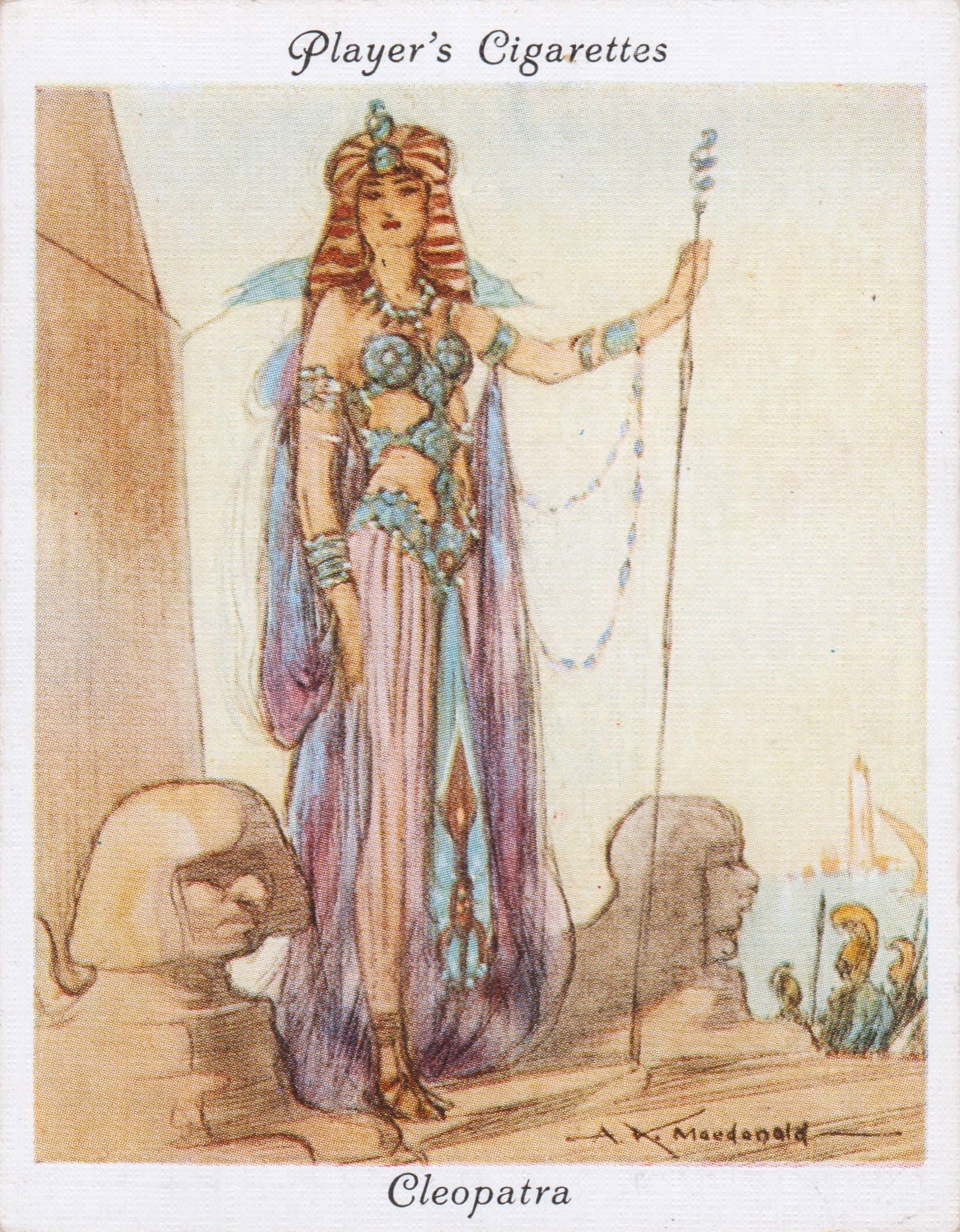
Card n.3 of the FAMOUS BEAUTIES series
JOHN PLAYER & SONS in 1937
(personal collection)
The analysis of "Cleopatra" as a cultural phenomenon requires an exploration of its roots in the socio-historical context of the time, examining how the film reflects and influences contemporary perceptions of female power and royalty. In addition, it is essential to consider the role of this blockbuster in the evolution of cinematic language and in the definition of the aesthetic canons that will continue to shape future productions. DeMille's film, therefore, is not only a masterpiece of its time, but also a reference point for the study of the history of cinema and its ability to capture the collective imagination.
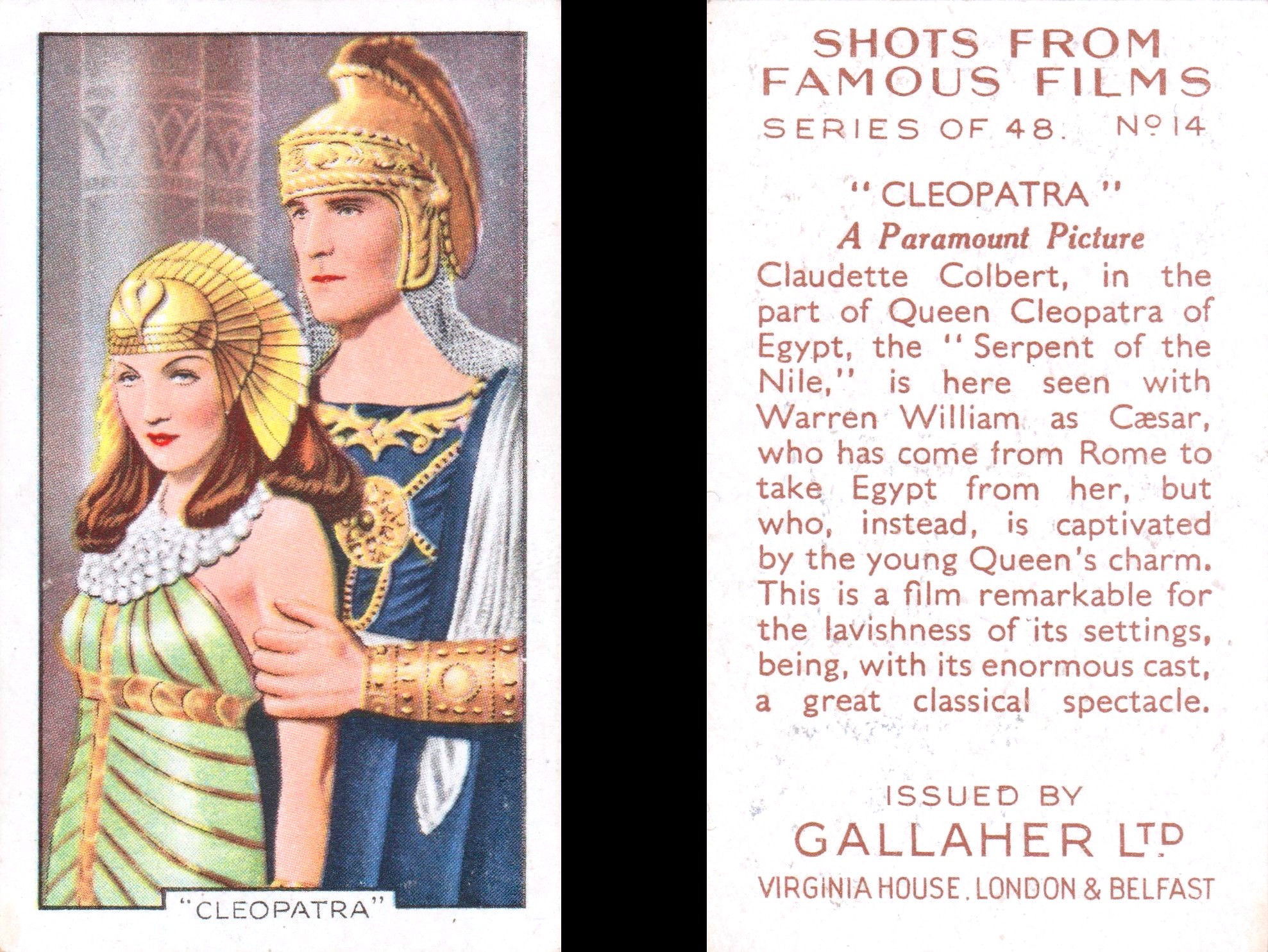
Card n.14 - SHOTS FROM FAMOUS FILMS
GALLAHER Ltd (1935)
(personal collection)
"Cleopatra" from 1934 is a work that deserves to be studied and appreciated not only for its intrinsic value as entertainment, but also as a historical document that offers food for thought on twentieth-century society, culture and art. His legacy endures, stimulating discussions and analyses that transcend the cinematic medium, testifying to the power of cinema as an art form capable of influencing and inspiring generations.
THE CAST
The 1934 film "Cleopatra," directed by Cecil B. DeMille, is a classic of epic cinema, known for its grandeur and elaborate set design. The cast of the film is made up of very talented actors who helped make this film a masterpiece of its time.

Cards pag. 21 positions 2 and 7
BUNDLE OF MOVIE PICTURES ALBUM 7
(personal collection)
Claudette Colbert plays the role of Queen Cleopatra. Her performance was acclaimed for its strength and nuance, offering a vision of the Egyptian queen who has become iconic.
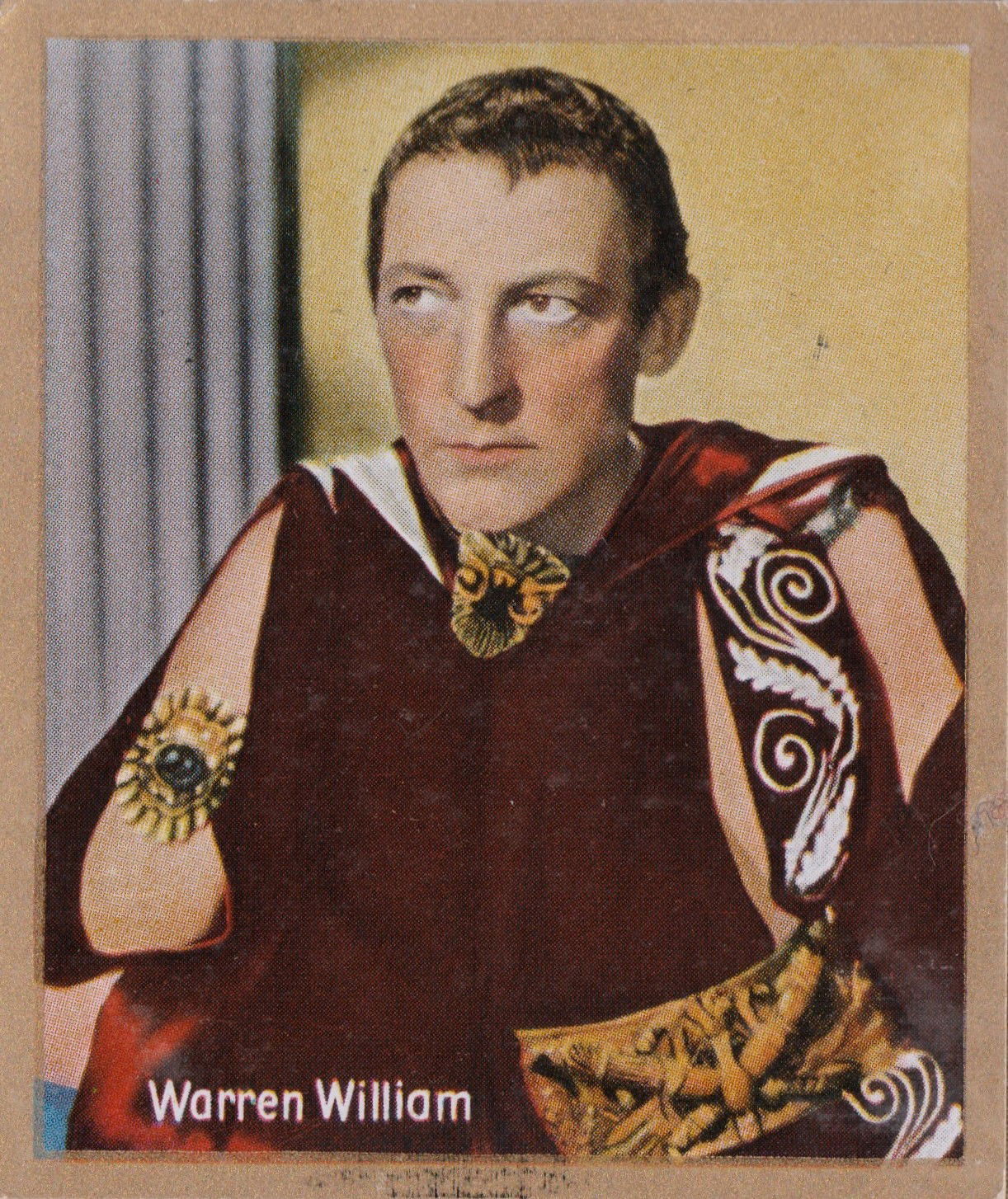
Card pag. 21 Position 3
BUNDLE OF MOVIE PICTURES ALBUM 7
(personal collection)
Warren William plays Julius Caesar, the powerful Roman general who becomes Cleopatra's lover. His performance added depth and charisma to the historical figure.
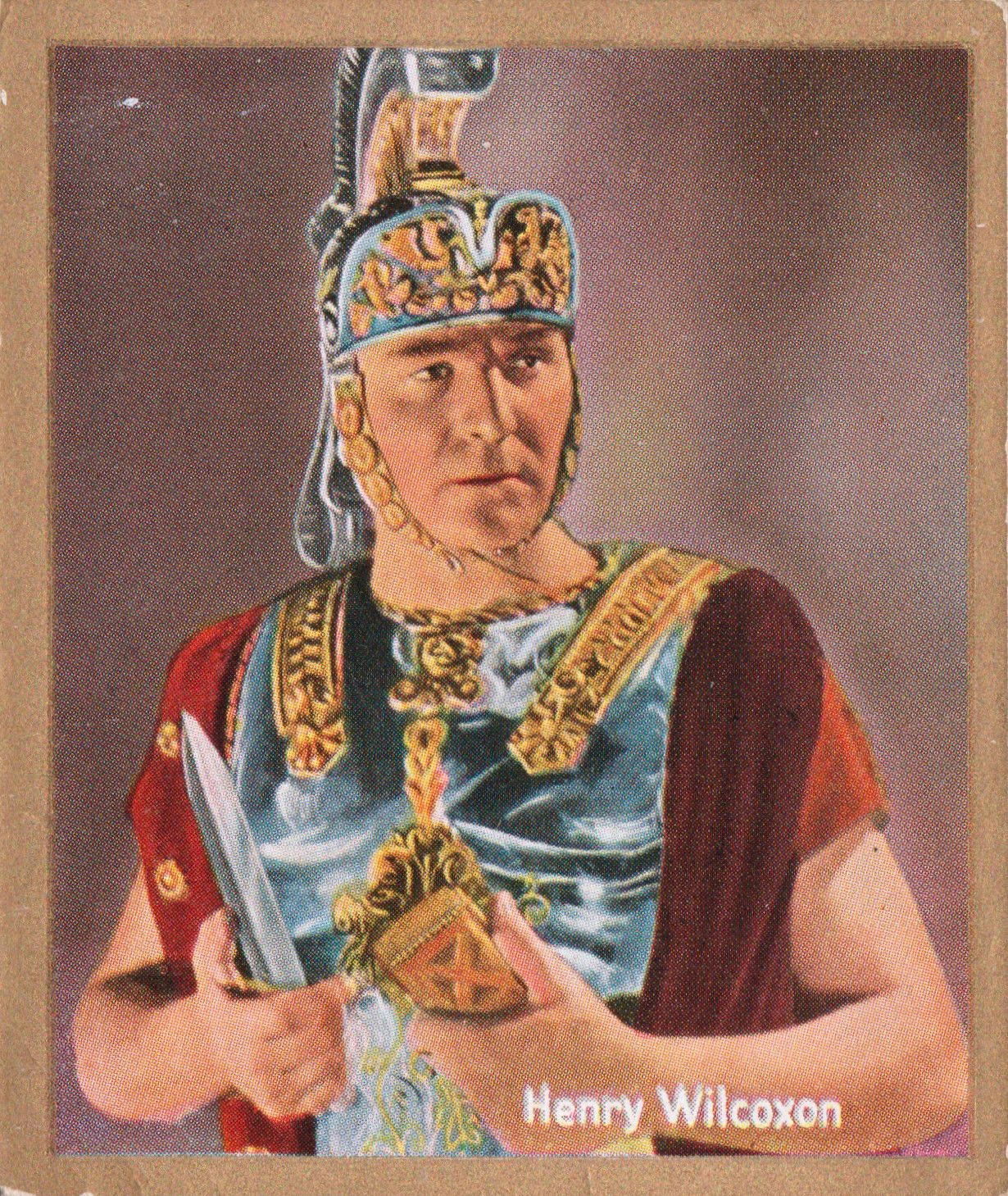

Card pag. 21 Position 1
BUNDLE OF MOVIE PICTURES ALBUM 7
(personal collection)
Henry Wilcoxon takes on the role of Mark Antony, the Roman general who falls in love with Cleopatra after Caesar's death. His performance helped to create an intense and dramatic dynamic between the main characters.
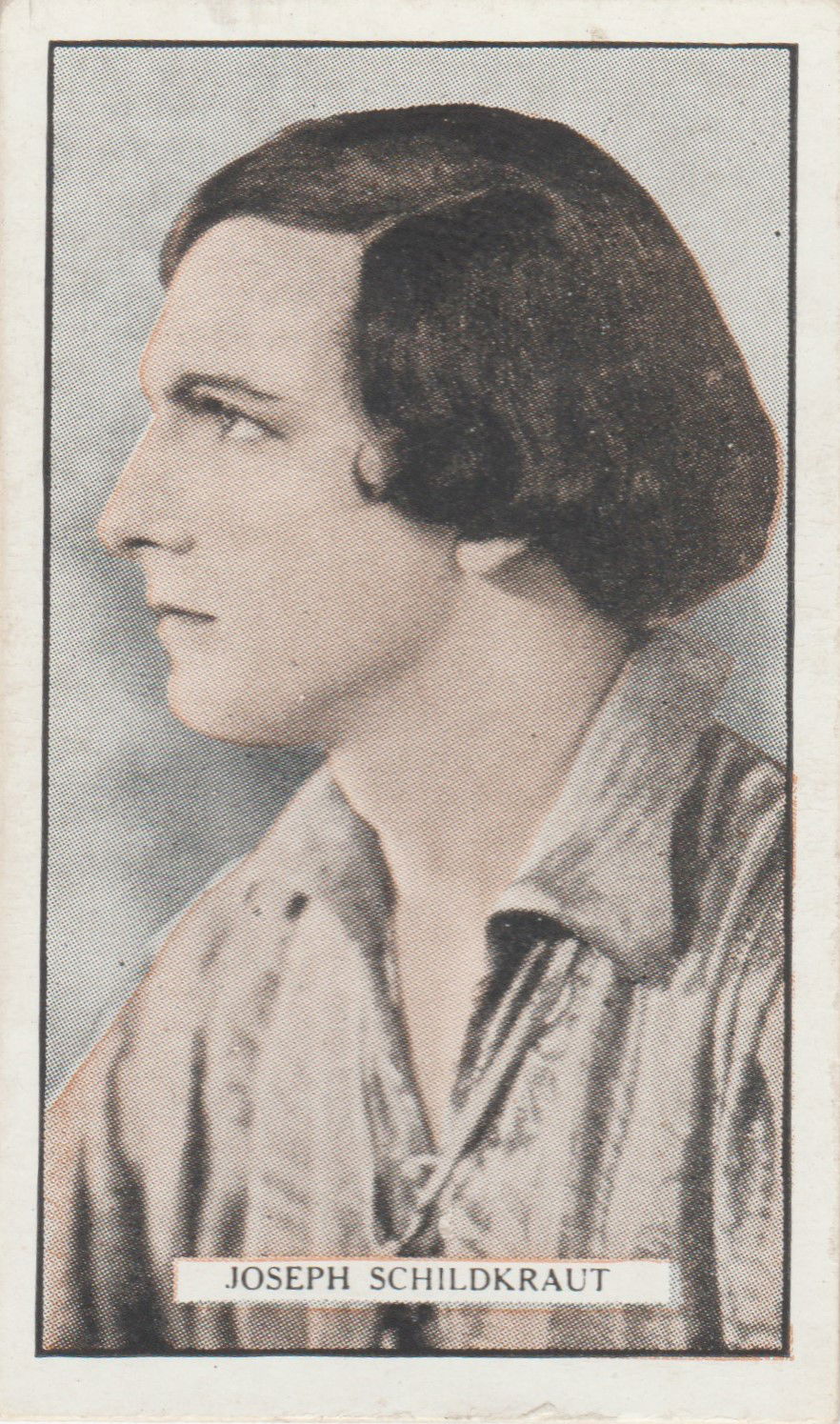
Sticker n.73 of the CINEMA STARS series
GALLAHER LTD (1926)
(personal collection)
Joseph Schildkraut plays Herod, adding an extra layer of complexity to the plot with his stage presence and acting prowess.
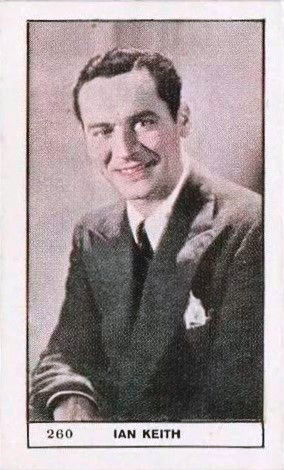
Sticker n.260 of the CINEMA STARS series
B.A.T. (1932)
(personal collection)
Ian Keith plays Octavian, the future emperor Augustus, who clashes with Mark Antony for control of Rome and Egypt.
Other cast members include Gertrude Michael as Calpurnia, C. Aubrey Smith as Ahenobarbus, Irving Pichel as Apollodorus, Arthur Hohl as Brutus, Edwin Maxwell as Casca, Eleanor Phelps as Charmion, Leonard Mudie as Pothinus, Grace Durkin as Iras, and Claudia Dell as Octavia. The cast of 1934's "Cleopatra" played a crucial role in the film's success, with memorable performances helping to create an epic cinematic experience. The combination of established talents and new promises has made this film a reference point in the genre of historical blockbusters.
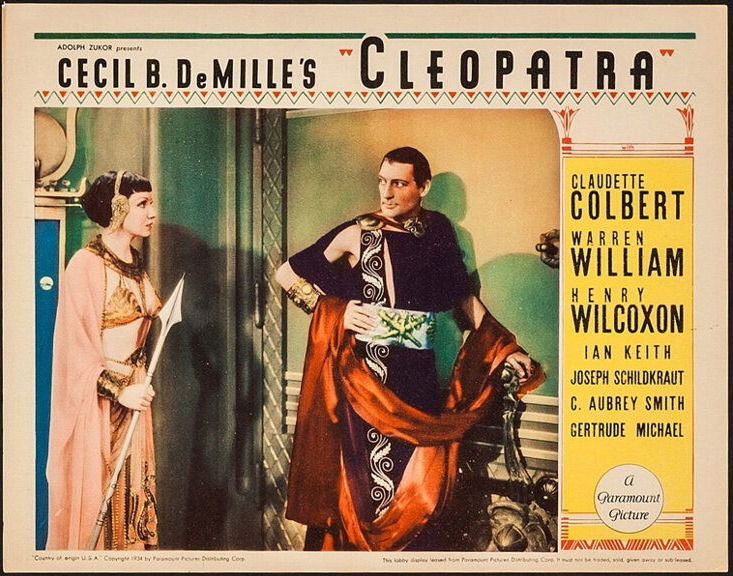
US LOBBY CARD (1934)
